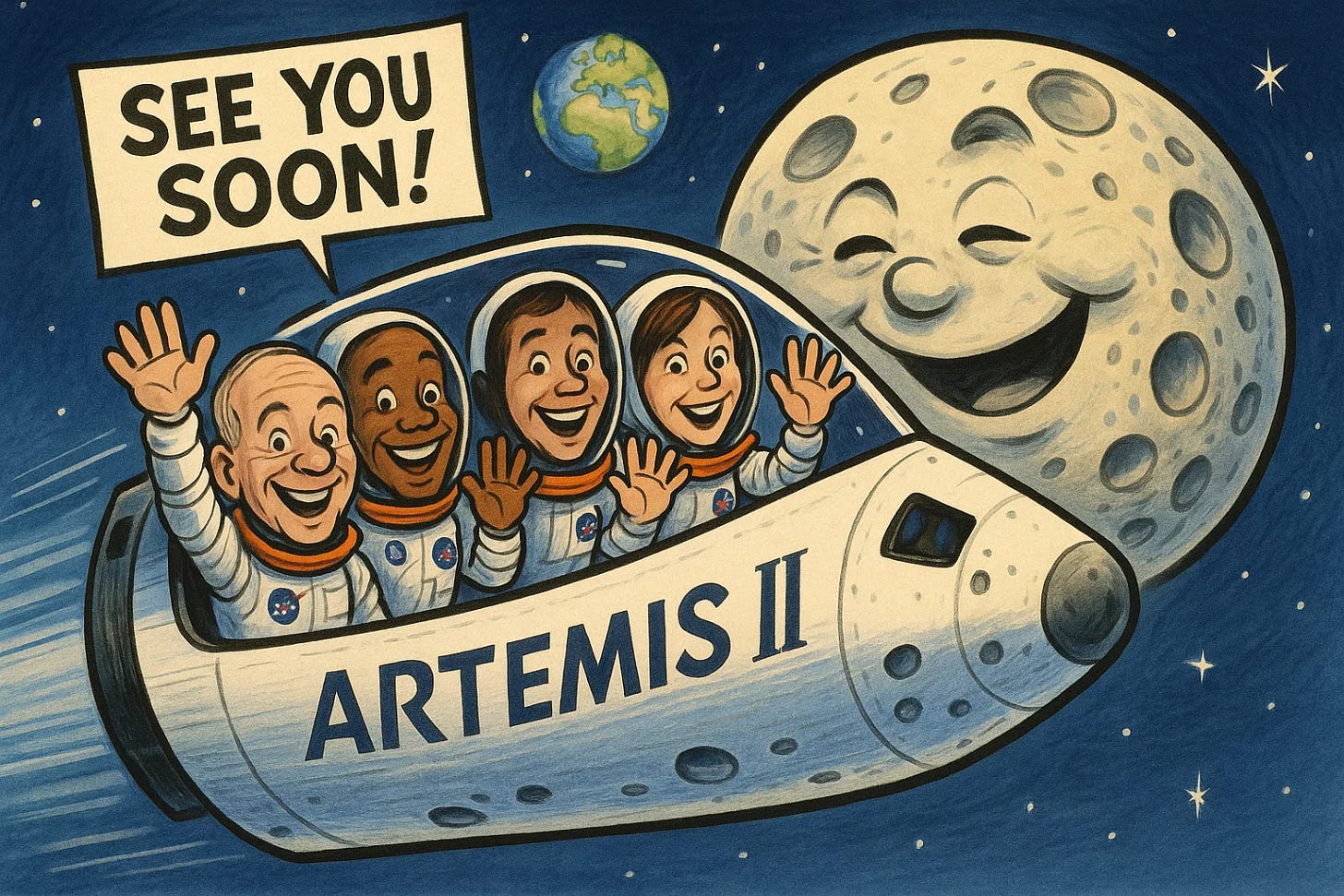🖋️ Think Like a Human, Code Like a Machine
👋 Welcome! Today’s issue dives into vibe coding—the art of building with prompts, not syntax. We explore its creative power, real limits, and why knowing how to guide AI might be the next essential tech skill!
In partnership with
all-in-one platform to manage and scale entrepreneurship communities, opportunities, and innovation.
AI & TECH
NASA Eyes Crewed Moon Mission – For the first time in 50 years, astronauts are set to fly around the Moon. NASA’s Artemis II mission, scheduled for February, will send four crew members on a ten-day journey to test spacecraft systems. The mission won’t land, but it’s designed to pave the way for future lunar exploration and long-term human presence in space. If successful, it will be the farthest humans have traveled since Apollo 17.
Mobile Vibe Coding Apps Stall – Despite billions in funding and hype, AI-powered “vibe coding” apps on mobile haven’t taken off. Top players like Instance: AI App Builder have only 16,000 downloads and minimal revenue. Most experimentation still happens on desktop, though startups like Vibecode are trying to change that. The interest is real, but mobile vibe coding clearly isn’t ready for prime time yet.
Google Photos Adds AI Editing – Android users can now edit photos in Google Photos simply by texting or talking to AI. The Gemini-powered tool handles adjustments, object removal, restorations, or even playful creative edits. Accessible via “Help me edit,” it also supports follow-up requests. Initially Pixel-exclusive, the feature is now rolling out broadly to U.S. Android users 18 and up.
Kojima, Niantic Team on AR Game – Hideo Kojima’s studio is partnering with Pokémon GO creator Niantic Spatial for a new augmented reality project. Teased with the tagline “move beyond the screen,” the project aims to blend real-world environments with digital storytelling. Kojima described it as “like the real Death Stranding in the real world,” promising exploration, connection, and shared play.
CAREER & WORK
Google Manager on AI Coding Future – Ryan Salva, Google’s dev tools lead, says AI coding is shifting developers’ roles from coders to architects. Using Gemini CLI and other tools, his team relies on AI to draft requirements, troubleshoot, and self-correct code. The shift suggests developers will increasingly focus on breaking down complex problems, while AI handles execution and iteration.
Jaguar Land Rover Jobs at Risk – Jaguar Land Rover has extended its UK factory shutdown until at least October 1 following a cyberattack, leaving workers sidelined for a third week. While the company promises a phased restart, the uncertainty is fueling concern among employees and suppliers, some warning the prolonged pause could threaten contracts, stability, and future jobs.
Accenture Eyes 12,000 New Jobs – Accenture plans a new campus in Visakhapatnam, Andhra Pradesh, potentially adding 12,000 jobs. The consultancy has requested 10 acres under a state policy offering ultra-low land leases to firms creating employment. India already hosts 300,000 of Accenture’s 790,000 workers, making it its largest base. Approvals are pending, but clearance is expected.
ECONOMY & FINANCE
EU Moves to Curb US Tech – The EU is finalizing its Financial Data Access (FiDA) rules, likely excluding Apple, Google, Meta, and Amazon from shared financial data systems. Banks back the plan to protect consumer sovereignty, while critics warn it limits innovation. Trump has threatened tariffs in response, escalating economic tensions between Washington and Brussels.
Chinese Carmakers Surpass Renault, Audi – Chinese automakers outsold Renault and Audi in Europe this August, driven by booming plug-in hybrid demand. BYD, Chery, and MG placed models in the top ten, helping Chinese brands hit 43,500 sales—up 121% year-on-year—as PHEV sales surged 59% across 28 European countries, reshaping Europe’s auto market.
Sila Opens First US Anode Plant – Backed by $375M in funding, Sila opened the West’s first large-scale silicon anode factory in Washington. The site could expand from powering 50,000 EVs annually to 2.5 million, positioning the startup as a major U.S. battery supplier in the global race for energy-dense, cost-competitive cells.
VC & FUNDING
Rocket.new Lands $15M Seed Round – India’s Rocket.new raised $15M from Salesforce Ventures, Accel, and Together Fund to scale its AI-powered vibe-coding platform. Launched in June, it already counts 400,000 users and $4.5M ARR, aiming to hit $60–70M by mid-2026 with global expansion and proprietary R&D.
Superpanel Raises $5.3M for Legal AI – AI startup Superpanel secured $5.3M seed funding, co-led by Outlander VC and Field Ventures, to automate legal intake. The platform acts as a “digital teammate” for plaintiff law firms, streamlining onboarding, compliance, and case sorting while reducing costly bottlenecks.
BIG THINK
Riding the Vibe: What Vibe Coding Means for All of Us
Vibe coding is shaking up what it means to build software. Instead of writing every line by hand, you describe what you want in natural language, and an AI translates that into working code. Andrej Karpathy introduced the idea early in 2025. The goal is to speed up prototyping, make technology more accessible, and let people focus on ideas over syntax.
One of the biggest advantages is accessibility. If you’ve ever had an idea for a cool app but didn’t have the time to code the foundations, vibe coding lowers that barrier. You can iterate quickly, experiment, test, and change direction without deep dives into boilerplate code. It’s especially appealing for hobbyists, solo creators, and people with more vision than technical training.
But it’s not all sunshine and flow‑state. Vibe coding comes with real trade‑offs. Because you often accept AI‑generated code without digging into every detail, bugs, security weaknesses, or messy structural issues can slip through. Large or critical applications tend to suffer more from these shortcomings. Also, there’s a risk that people who rely heavily on vibe coding might skip learning fundamental coding skills, which makes debugging and long‑term maintenance harder.
Why does it matter that more people understand vibe coding—not just developers? First, it frames realistic expectations: knowing where vibe coding shines (prototyping, low‑stakes apps, exploration) vs where it might be risky (high‑reliability systems, large scale). Second, public understanding helps set norms and accountability—like demanding code quality, security, transparency in tools used, and clear communication about what "AI‑generated code" really means.
In short: vibe coding feels like a potent shift in how software gets made—one more conversational, more idea‑driven, more experimental. But it doesn’t replace essentials like rigorous testing, structure, and skill. It works best when paired with oversight and technical insight—not as a full shortcut.
What’s exciting is that vibe coding could help unlock a broader creative class—not just traditional developers, but designers, writers, educators, and entrepreneurs—who now have a way to bring digital ideas to life. It invites a more playful, intuitive approach to building, where curiosity matters as much as credentials. If paired with thoughtful learning and safeguards, vibe coding could be less about replacing skills and more about redistributing creative power—turning software into something more people can shape, remix, and truly make their own.
Actionable Insights
Review Before You Ship—use code review, version control, and basic audits—even for AI-generated prototypes.
Know the Basics—learn core coding concepts to guide, fix, or assess AI-written code.
JOBS & OPPORTUNITIES
Software Engineer | Contract | Lewisville, TX | In Person
Solution Architect | Contract | Chicago, IL | In Person
Client Success Consultant | Full Time | Chicago, IL | In Person
Product Security Engineer | Full Time | Plano, TX | Hybrid
R&D Software Engineer Intern | Full Time | Arden Hills, MN | In Person
Global Business Development Manager | Part Time | Year-round | Hybrid
Campaign Marketing Manager | Full Time | Charlotte, NC | Hybrid
Have a job or opportunity to share? Post for free here and we will highlight a few each week!
PROMOTE YOUR BRAND TO EVERY PATH READERS
Reach a highly targeted audience of tens of thousands of young professionals who turn to Every Path for trusted insights on AI, tech, careers, and finance.
Partner with us to put your message in front of entrepreneurs, founders, developers, investors — Gen Z and millennial decision-makers looking for tools to thrive in today’s changing world of work. Ready to grow your brand with us?
THE NUMBER:
of power will be needed by data centers in 2028. That’s enough to turn the internet into its own nation, proudly running on memes and machine learning.
WISDOM:
“Don't say 'infinitely' when you mean 'very'; otherwise you'll have no word left when you want to talk about something really infinite”.










